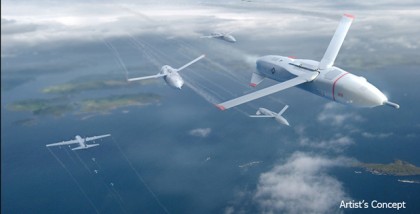For decades, U.S. military air operations have relied on increasingly capable multi-function manned aircraft to execute critical combat and non-combat missions. Adversaries’ abilities to detect and engage those aircraft from longer ranges have improved over time as well, however, driving up the costs for vehicle design, operation and replacement. An ability to send large numbers of small unmanned air systems (UAS) with coordinated, distributed capabilities could provide U.S. forces with improved operational flexibility at much lower cost than is possible with today’s expensive, all-in-one platforms—especially if those unmanned systems could be retrieved for reuse while airborne. So far, however, the technology to project volleys of low-cost, reusable systems over great distances and retrieve them in mid-air has remained out of reach.
To help make that technology a reality, DARPA has launched the Gremlins program. Named for the imaginary, mischievous imps that became the good luck charms of many British pilots during World War II, the program seeks to show the feasibility of conducting safe, reliable operations involving multiple air-launched, air-recoverable unmanned systems. The program also aims to prove that such systems, or “gremlins,” could provide significant cost advantages over expendable systems, spreading out payload and airframe costs over multiple uses instead of just one.
“Our goal is to conduct a compelling proof-of-concept flight demonstration that could employ intelligence, surveillance and reconnaissance (ISR) and other modular, non-kinetic payloads in a robust, responsive and affordable manner,” said Dan Patt, DARPA program manager.
The Gremlins program seeks to expand upon DARPA’s Request for Information (RFI) last year, which invited novel concepts for distributed airborne capabilities. It also aims to leverage DARPA’s prior success in developing automated aerial refueling capabilities, as well the Agency’s current efforts to create advanced UAS capture systems for ships.
The program envisions launching groups of gremlins from large aircraft such as bombers or transport aircraft, as well as from fighters and other small, fixed-wing platforms while those planes are out of range of adversary defenses. When the gremlins complete their mission, a C-130 transport aircraft would retrieve them in the air and carry them home, where ground crews would prepare them for their next use within 24 hours.
DARPA plans to focus primarily on the technical challenges associated with safe, reliable aerial launch and recovery of multiple unmanned air vehicles. Additionally, the program will address new operational capabilities and air operations architectures as well as the potential cost advantages.
With an expected lifetime of about 20 uses, Gremlins could fill an advantageous design-and-use space between existing models of missiles and conventional aircraft, Patt said. “We wouldn’t be discarding the entire airframe, engine, avionics and payload with every mission, as is done with missiles, but we also wouldn’t have to carry the maintainability and operational cost burdens of today’s reusable systems, which are meant to stay in service for decades,” he said. Moreover, gremlin systems could be relatively cost-efficient if, as expected, they leverage existing technology and require only modest modifications to current aircraft.
Press release and image DARPA


